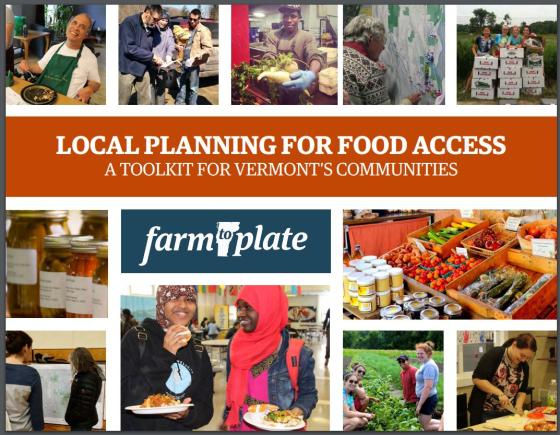Posted February 10, 2020 at 08:58am by Kelly Nottermann
Local Planning for Food Access Toolkit Provides Free Planning Resources for Vermont Communities

Everyone needs to eat. Simple, right? Food, a basic necessity, seems so straightforward, but for many Vermonters, getting affordable and nutritious food can be difficult. From children to older Vermonters, the difficulties in getting enough food that is affordable and nutritious are many. The Vermont Farm to Plate Network recently launched a Local Planning for Food Access Toolkit, a free resource focused on improving food access through municipal and regional plans. The toolkit, created with support and input from 20 experts from a wide range of food system organizations, state agencies, and regional commissions, is available at bit.ly/F2PFoodAccessToolkit.
Plans alone won’t solve hunger, but the planning process can raise awareness and build
broad public support for food access initiatives. Through local and regional planning, with widespread input from diverse community members, a planning commission gathers data and community input, assesses and inventories available resources, identifies existing needs and gaps, and then develops goals, policies, and action items to lead the community into the future. Despite hunger and food access not being among the required elements in Vermont plans, there are a wide variety of ways to address food access in plans.
Hunger exists in every community whether it is visible or not. Inside the toolkit, users will find ideas and, hopefully, inspiration for their community. It is both a guide for integrating food access into local and regional planning processes and a call to action for community members. Toolkit users can choose from many different strategies for increasing food access, with resources and information to help a community determine the best approach to take for their circumstances.
“Like water and shelter, food access is one of those things we take for granted until it’s not there. Access to food is more than a function of being able to pay for it,” said Chris Campany, executive director of the Windham Regional Commission. “It’s also a function of mobility, land use, local economic conditions and other factors. Can you get to where the food is, or can the food get to you? Do local land use regulations create barriers to food production and access? What kinds of food and food retail does the local economy currently support? Food access requires thoughtful and intentional planning and implementation. This Toolkit provides a foundation for multiple food access planning pathways for citizen planners.”
Also contained within the toolkit are numerous success stories from communities all around the state that show how other communities are addressing their challenges. Featured successes include the Duxbury Town Plan Chapter on Food and Agriculture, St. Albans’ Local Food Local Places initiative with the Northwest Healthy Roots Collaborative, the Brownsville Community Store, Fresh Start Community Farm in Newport, C.I.D.E.R. in Grand Isle, and nutrition education in Morristown.
“Supporting the economic viability of local farms and increasing food access for all community members are often treated as separate, or even conflicting, objectives,” said Sarah Danly, Farm to Plate Network manager at the Vermont Sustainable Jobs Fund. “The Farm to Plate Network, however, works to address these issues simultaneously, as both are necessary for economic stability and thriving communities.”
The process of building the toolkit brought together a coalition of organizations with a shared interest in empowering Vermont’s communities to address food access at the local level. Local Planning for Food Access not only provides information for those communities ready to get to work, but also illustrates the common ground between those working on food access, economic welfare, housing, transportation, and more.
Over the coming year, Farm to Plate will provide on-the-ground advising for interested communities. Bringing a wide variety of expertise directly into communities is the key to making lasting impact, as the project has affirmed that every community’s local food system challenges and opportunities are complex and unique. To start a conversation in your community around local food access, visit bit.ly/F2PFoodAccessToolkit and email sarah@vsjf.org to learn more about hosting a workshop in your community.
ABOUT FARM TO PLATE:
Farm to Plate is Vermont’s statewide food system plan implemented by 350+ member organizations of the Farm to Plate Network to meet the goals of legislation passed in 2009 calling for increased economic development and jobs in the farm and food sector and improved access to healthy local food for all Vermonters. Vermont’s farm to plate food system plan is the most comprehensive in the country and the only state that has complete government engagement. In 2019, Vermont Farm to Plate was reauthorized beyond 2020. Governor Phil Scott signed into law H.275 – an act relating to the Farm-to-Plate Investment Program.The program is managed by the Vermont Sustainable Jobs Fund, a non-profit organization based in Montpelier, Vermont. www.VTFarmtoPlate.com
###
